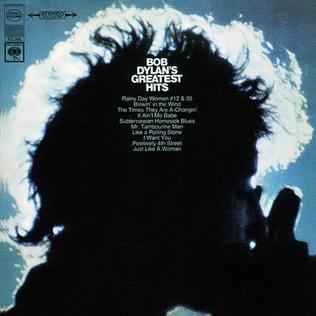Recorded 1962–1966 | Length 40:44 Release date 27 March 1967 Genres Rock music, Folk music | |
 | ||
Released March 27, 1967 (1967-03-27) Bob Dylan's Greatest Hits(1967) John Wesley Harding(1967) Awards Grammy Award for Best Album Cover, Photography Similar Bob Dylan albums, Folk music albums | ||
Bob Dylan's Greatest Hits is the first compilation album by American singer-songwriter Bob Dylan, released on March 27, 1967 on Columbia Records, original catalogue number KCS 9463. It contains every Top 40 single Dylan enjoyed through 1967. It peaked at #10 on the pop album chart in the United States, and went to #3 on the album chart in the United Kingdom. Certified five times platinum by the RIAA, it is his best-selling album in the U.S.
Contents
Content
Greatest Hits presented Dylan's first appearance on records after his praised Blonde on Blonde double-LP of May 1966 and his motorcycle accident of that summer. With no activity by Dylan since the end of his recent world tour, and no new recordings on the immediate horizon (the sessions that would in part be later released as the Basement Tapes were still months away), Columbia needed new product to continue to capitalize on Dylan's commercial appeal. Hence the appearance of this package, the label's first Dylan compilation and its first LP release with a $5.98 list price, one dollar more than that of standard releases.
Greatest Hits serves as Dylan's de facto singles collection for the 1960s. With the exception of "The Times They Are a-Changin'," "It Ain't Me Babe," and "Mr. Tambourine Man," all tracks on this album were released as 45 RPM singles in the United States during that decade. It is worth noting that in 1963 "Blowin' in the Wind" became a #2 hit single for Peter, Paul and Mary, and that in 1965 "Times" made it to #9 as a single release in the United Kingdom. That same year of 1965 a truncated rock and roll version of "Mr. Tambourine Man" had been a number one hit for The Byrds in the summer, and the Turtles took a folk-rock version of "It Ain't Me Babe" to #8. The remaining six tracks all made the Billboard Top 40 in 1965 and 1966. Perhaps the most astounding thing concerning this collection is that it documents a time in America when the lyric complexity and philosophic bent of "Like a Rolling Stone," "Positively Fourth Street," and "Rainy Day Women #12 & 35" could actually become top ten pop hits. "Positively 4th Street" was the only single of the collection not either later released on or taken off a long-playing album, having been recorded during the sessions for Highway 61 Revisited.
When this album was remastered for its 1997 issue on compact disc 30 years later, a slightly longer alternate mix of "Positively 4th Street" was substituted for the original single version. In 2003, this album was released along with Dylan's two other greatest hits compilations in one four-disc boxed set, as Greatest Hits Volumes I–III.
An audiophile version of the album was released in August 2012, mastered by Steve Hoffman for the Audio Fidelity label as a 24-kt gold-plated CD. This disc is a limited edition of 5,000 individually numbered copies. Like the 1997 remaster, this CD contains a longer version of "Positively 4th Street."
Artwork
The cover photograph of Bob Dylan's Greatest Hits was taken by Rowland Scherman at Dylan's November 28, 1965, concert in Washington, D.C. The Bob Cato cover won the 1967 Grammy award for "Best Album Cover, Photography". The original album package also included Milton Glaser's now-familiar "psychedelic" poster depicting Dylan. A similar image taken at the Concert for Bangladesh in 1971 was selected for Bob Dylan's Greatest Hits Vol. II, a compilation Dylan had much more control over. John Berg, Senior Art Director at Columbia Records, recognized that a backlit image such as Scherman's would work because of Dylan's unique sartorial style. It was his design, as well as Scherman's photo, that won the Grammy.
Track listing
All tracks written by Bob Dylan and all releases Columbia Records. Chart positions from Billboard Hot 100. In most cases the LP featured album versions in place of singles if such were not identical to single mixes.
Great Britain and Ireland
The UK release of the album had a slightly different track listing. "Positively 4th Street" was omitted, but "She Belongs to Me," "It's All Over Now, Baby Blue," and "One of Us Must Know (Sooner or Later)" were added. In the UK, this album was followed up by Bob Dylan's Greatest Hits 2, which repeated the Blonde on Blonde songs from the first Greatest Hits and also added "Absolutely Sweet Marie," "Just Like Tom Thumb's Blues," "Gates of Eden," "Chimes of Freedom," and several others. This album was different from the album called Bob Dylan's Greatest Hits Vol. II in the US, which was released in 1971 and called More Bob Dylan Greatest Hits in the UK.
Europe
Subtitled "Nobody sings Dylan like Dylan", this version was compiled in 1966. Only half of the 12 songs are also on the U.S. release. Songs from Blonde on Blonde are missing altogether.
Songs
1Rainy Day Women #12 & 354:37
2Blowin' in the Wind2:49
3The Times They Are a-Changin'3:15
